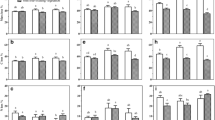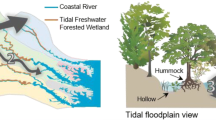Abstract
Vegetation both physically and biochemically influences denitrification in wetlands. Litter from various plant species supplies various amounts and qualities of organic carbon to denitrifying bacteria, and may thus affect denitrification capacity. We explore whether there is seasonal variation in the denitrification potential in stands of Glyceria maxima, Phragmites australis, Typha latifolia, and Potamogeton pectinatus (the stands differed in terms of which species was predominant). Experiments and measurements investigated whether denitrification potential was related to organic matter and its availability to denitrifying bacteria, suitability for bacterial growth, and amount in the wetland. Availability of organic material, as measured in the slurries, was highest in the G. maxima and P. pectinatus samples, with the highest availability in May and August. However, when the samples were closer to wetland conditions, i.e., intact sediment cores containing litter and organic sediment, the denitrifying capacity was highest in the cores from G. maxima stands, but lowest in P. pectinatus cores. In addition, the denitrification potential of the intact cores was highest in November. Differences in denitrification capacity between the slurries and intact sediment cores, considering the organic material of the plant species and the seasonal pattern, were attributed to differences in the amount of plant litter generated.




Similar content being viewed by others
References
Bachand, P. A. M., & Horne, A. J. (2000). Denitrification in constructed free-water surface wetlands: II. Effects of vegetation and temperature. Ecological Engineering, 14, 17–32.
Balderston, W. L., Sherr, B., & Payne, W. J. (1976). Blockage by acetylene of nitrous oxide reduction in Pseudomonas perfectomarinus. Applied and Environmental Microbiology, 31, 504–508.
Bastviken, S. K., Eriksson, P. G., Martins, I., Neto, J. M., Leonardson, L., & Tonderski, K. (2003). Potential nitrification and denitrification on different surfaces in a constructed treatment wetland. Journal of Environmental Quality, 32, 2414–2420.
Bastviken, S. K., Eriksson, P. G., Premrov, A., & Tonderski, K. (2005). Potential denitrification in wetland sediments with different plant species detritus. Ecological Engineering, 25, 183–190.
Belova, M. (1993). Microbial decomposition of freshwater macrophytes in the littoral zone of lakes. Hydrobiologia, 251, 59–64.
Dykyjová, D., & Kvet, J. (1978). Pond littoral ecosystems: Structure and functioning: Methods and results of quantitative ecosystem research in the Czechoslovakian IBP wetland project. Berlin Heidelberg New York: Springer.
Eriksson, P. G., & Andersson, J. L. (1999). Potential nitrification and cation exchange on litter of emergent, freshwater macrophytes. Freshwater Biology, 42, 479–486.
Eriksson, P. G., & Weisner, S. E. B. (1996). Functional differences in epiphytic microbial communities in nutrient-rich freshwater ecosystems: An assay of denitrifying capacity. Freshwater Biology, 36, 555–562.
Eriksson, P. G., & Weisner, S. E. B. (1997). Nitrogen removal in a wastewater reservoir: The importance of denitrification by epiphytic biofilms on submersed vegetation. Journal of Environmental Quality, 26, 905–910.
Gale, P. M., Dévai, I., Reddy, K. R., & Graetz, D. A. (1993). Denitrification potential of soils from constructed and natural wetlands. Ecological Engineering, 2, 119–130.
Godshalk, G. L., & Wetzel, R. G. (1978a). Decomposition in the littoral zone of lakes. In: R. E. Good, D. G. Whigham, & R. L. Simpson (Eds.), Freshwater wetlands: Ecological processes and management potential (pp. 131–143). New York: Academic.
Godshalk, G. L., & Wetzel, R. G. (1978b). Decomposition of aquatic angiosperms. II. Particulate components. Aquatic Botany, 5, 301–327.
Hamilton, W. A. (1987). Biofilms: Microbial interactions and metabolic activities. In M. Fletcher, T. R. G. Gray, & J. G. Jones (Eds.), Ecology of microbial communities (pp. 361–385). Cambridge: Cambridge University Press.
Hume, N. P., Fleming, M. S., & Horne, A. J. (2002). Denitrification potential and carbon quality of four aquatic plants in wetland microcosms. Soil Science Society of America Journal, 66, 1706–1712.
Ingersoll, T. L., & Baker, L. A. (1998). Nitrate removal in wetland microcosms. Water Research, 32, 677–684.
Kadlec, R. H. (2005). Nitrogen farming for pollution control. Journal of Environmental Science and Health, 40, 1307–1330.
Klemedtsson, L., Klemedtsson, Å. K., Moldan, F., & Weslien, P. (1997). Nitrous oxide emission from Swedish forest soils in relation to liming and simulated increased N-deposition. Biology and Fertility of Soils, 25, 290–295.
Körner, S. (1999). Nitrifying and denitrifying bacteria in epiphytic communities of submerged macrophytes in a treated sewage channel. Acta Hyrochim. Hydrobiol., 27, 27–31.
Kozub, D. D., & Liehr, S. K. (1999). Assessing denitrification rate limiting factors in a constructed wetland receiving landfill leachate. Water Science and Technology, 40, 75–82.
Lin, Y., Jing, S., Wang, T., & Lee, D. (2002). Effects of macrophytes and external carbon sources on nitrate removal from groundwater in constructed wetlands. Environmental Pollution, 119, 413–420.
McJannet, C. L., Keddy, P. A., & Pick, F. R. (1995). Nitrogen and phosphorus tissue concentrations in 41 wetland plants: A comparison across habitats and functional groups. Functional Ecology, 9, 231–238.
Moran, M. A., & Hudson, R. F. (1989). Bacterial secondary production on vascular plant detritus: Relationships to detritus composition and degradation rate. Applied and Environmental Microbiology, 55, 2178–2189.
Nielsen, L. P., Christensen, P. B., Revsbech, N. P., & Sørensen, J. (1990). Denitrification and oxygen respiration in biofilms studied with a microsensor for nitrous oxide and oxygen. Microbial Ecology, 19, 63–72.
Porter, K. G., & Feig, Y. S. (1980). The use of DAPI for identifying and counting aquatic microflora. Limnology and Oceanography, 25, 943–948.
Reddy, K. R., & Patrick, W. H. (1984). Nitrogen transformations and loss in flooded soils and sediments. Critical Reviews in Environmental Control, 13, 273–309.
Seitzinger, S. P., Neilsen, L. P., Caffrey, J., & Christensen, P. B. (1993). Denitrification measurements in aquatic sediments: A comparison of three methods. Biogeochemistry, 23, 147–167.
Sørensen, J., Jörgensen, T., & Brandt, S. (1988). Denitrification in stream epilithon: Seasonal variation in Gelbæk and Rabis Bæk, Denmark. FEMS Microbiology Ecology, 53, 345–354.
Thompson, S. P., Piehler, M. F., & Paerl, H. W. (2000). Denitrification in an estuarine headwater creek within an agricultural watershed. Journal of Environmental Quality, 29, 1914–1923.
Twilley, R. R., Ejdung, G., Romare, P., & Kemp, W. M. (1986). A comparative study of decomposition, oxygen consumption and nutrient release for selected aquatic plants occurring in an estuarine environment. Oikos, 47, 190–198.
Velji, M. J., & Albright, L. J. (1986). Microscopic enumeration of attached marine bacteria of seawater, marine sediment, fecal matter, and kelp blade samples following pyrophosphate and ultrasound treatment. Canadian Journal of Microbiology, 32, 121–126.
Westlake, D. F. (1966). The biomass and productivity of Glyceria maxima. I. Seasonal changes in biomass. Journal of Ecology, 54, 745–753.
Westlake, J., Kvêt, J., & Szczepanski, A. (1998). The production ecology of wetlands. Cambridge: Cambridge University Press.
Zhu, T., & Sikora, F. J. (1995). Ammonium and nitrate removal in vegetated and unvegetated gravel bed microcosm wetlands. Water Science and Technology, 32, 219–228.
Acknowledgments
The study was conducted as a part of the Swedish Water Management Research Program (VASTRA), financed by the Swedish Foundation for Strategic Environmental Research (MISTRA).
Author information
Authors and Affiliations
Corresponding author
Rights and permissions
About this article
Cite this article
Bastviken, S.K., Eriksson, P.G., Ekström, A. et al. Seasonal Denitrification Potential in Wetland Sediments with Organic Matter from Different Plant Species. Water Air Soil Pollut 183, 25–35 (2007). https://doi.org/10.1007/s11270-007-9352-x
Received:
Accepted:
Published:
Issue Date:
DOI: https://doi.org/10.1007/s11270-007-9352-x




